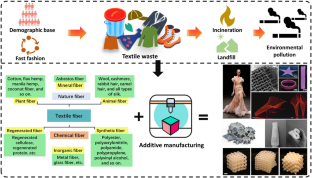Environmental Chemistry Letters ( IF 15.7 ) Pub Date : 2024-04-05 , DOI: 10.1007/s10311-024-01726-2 Weiqiang Fan , Yongzhen Wang , Rulin Liu , Jing Zou , Xiang Yu , Yaming Liu , Chao Zhi , Jiaguang Meng

|
The rapid growth of textile industry and fast-fashion has led to the production of about 92 million ton of textile waste per year. Nearly 85% of textile waste is disposed of by landfill and incineration, causing serious environmental pollution and huge resource waste, calling for alternative textile production. Here we review the green production of textiles with focus on additive manufacturing, 3- and 4-dimension printing, recycling textile waste, and synthetic and natural fibers. Additive manufacturing technologies, particularly 4-dimension printing, is flexible, green, and allows on-demand manufacturing, which is one solution to the textile waste problem. 4-Dimension printing contributes to the development of intelligent materials, and can create structures that deform in response to external stimuli. Textile waste contains high-quality, low-cost materials that can be re-used and recycled. Applications include smart textiles, flexible electronics, soft robotics, human–computer interaction, and wearable devices.
中文翻译:

增材制造和纺织废料回收的纺织品生产:综述
纺织工业和快时尚的快速增长导致每年产生约9200万吨纺织废料。近85%的纺织废料通过填埋和焚烧处理,造成严重的环境污染和巨大的资源浪费,呼吁替代纺织生产。在这里,我们回顾了纺织品的绿色生产,重点关注增材制造、3 维和 4 维印刷、回收纺织废料以及合成和天然纤维。增材制造技术,特别是 4 维打印,灵活、绿色且允许按需制造,是解决纺织品浪费问题的一种解决方案。 4 维打印有助于智能材料的开发,并且可以创建响应外部刺激而变形的结构。纺织废料含有高质量、低成本的材料,可以重复使用和回收。应用包括智能纺织品、柔性电子产品、软机器人、人机交互和可穿戴设备。



























 京公网安备 11010802027423号
京公网安备 11010802027423号